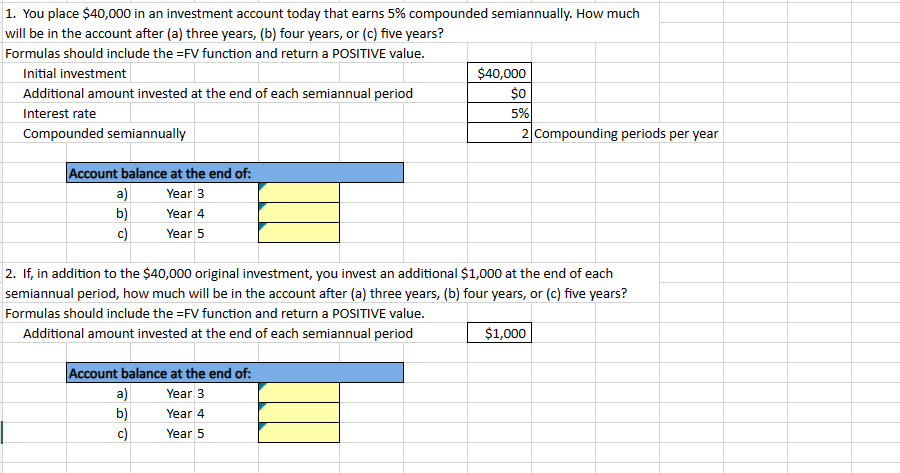You place $40,000 in an investment account today that earns 5% compounded semiannually. How much vill be in the account after (a) three years, (b) four years, or (c) five years? Formulas should include the =FV function and return a POSITIVE value. Initial investment Additional amount invested at the end of each semiannual period Interest rate Compounded semiannually Account balance at the end of: $40,000 $0 5% 2 Compounding periods per year a) Year 3 b) Year 4
You place $40,000 in an investment account today that earns 5% compounded semiannually. How much vill be in the account after (a) three years, (b) four years, or (c) five years? Formulas should include the =FV function and return a POSITIVE value. Initial investment Additional amount invested at the end of each semiannual period Interest rate Compounded semiannually Account balance at the end of: $40,000 $0 5% 2 Compounding periods per year a) Year 3 b) Year 4
Chapter5: The Time Value Of Money
Section: Chapter Questions
Problem 16P
Related questions
Question
100%
Please see image

Transcribed Image Text:1. You place $40,000 in an investment account today that earns 5% compounded semiannually. How much
will be in the account after (a) three years, (b) four years, or (c) five years?
Formulas should include the =FV function and return a POSITIVE value.
Initial investment
Additional amount invested at the end of each semiannual period
Interest rate
Compounded semiannually
Account balance at the end of:
$40,000
$0
5%
2 Compounding periods per year
a)
Year 3
b)
Year 4
c)
Year 5
2. If, in addition to the $40,000 original investment, you invest an additional $1,000 at the end of each
semiannual period, how much will be in the account after (a) three years, (b) four years, or (c) five years?
Formulas should include the =FV function and return a POSITIVE value.
Additional amount invested at the end of each semiannual period
Account balance at the end of:
$1,000
a)
Year 3
b)
Year 4
c)
Year 5
Expert Solution
This question has been solved!
Explore an expertly crafted, step-by-step solution for a thorough understanding of key concepts.
Step by step
Solved in 3 steps with 2 images

Knowledge Booster
Learn more about
Need a deep-dive on the concept behind this application? Look no further. Learn more about this topic, finance and related others by exploring similar questions and additional content below.Recommended textbooks for you

EBK CONTEMPORARY FINANCIAL MANAGEMENT
Finance
ISBN:
9781337514835
Author:
MOYER
Publisher:
CENGAGE LEARNING - CONSIGNMENT



EBK CONTEMPORARY FINANCIAL MANAGEMENT
Finance
ISBN:
9781337514835
Author:
MOYER
Publisher:
CENGAGE LEARNING - CONSIGNMENT



Cornerstones of Financial Accounting
Accounting
ISBN:
9781337690881
Author:
Jay Rich, Jeff Jones
Publisher:
Cengage Learning

Principles of Accounting Volume 2
Accounting
ISBN:
9781947172609
Author:
OpenStax
Publisher:
OpenStax College
